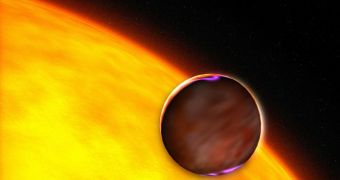A newly discovered exoplanet puzzles astronomers. Named XO-1b, the planet is the most massive found orbiting extremely close to its star, but it doesn't have a circular orbit, like most astronomers would have expected, but an elliptical one, which is very unusual, considering the short distance to its sun.
Discovered by a team of amateur and professional astronomers, the planet is a Goliath of gas giants, weighing 13 times more than our own gas giant, Jupiter. It takes this weird planet less than 4 days to perform a full revolution around the star, and it's considered a freak in the gas giants family.
"Of the 200-plus exoplanets found so far, XO-3b is an oddity in several respects," said XO Project director Peter McCullough, an astronomer at the Space Telescope Science Institute in Baltimore.
Another strange thing about it is the fact that during every orbit, it passes in front of its star, which makes it a "transiting planet," and puts it in the select club of just a few dozen others that act the same way, out of more than 200 exoplanets discovered so far.
The oddball started a controversy among astrophysicists, since its sheer size should have transformed it in a brown dwarf, one of the smallest stars, but somehow it was still classified as a planet. Brown dwarfs are too massive to be considered planets, yet they don't meet the "Sumo-weight" requirements for hydrogen fusion (about 80 Jupiters) so they fall short of being stars.
XO-3b is just at the boundary between brown-dwarf status and planet regarding its mass.
"We are intrigued that its mass is on the boundary between planets and 'brown dwarfs,'" said Christopher Johns-Krull, an astronomer at Rice University. "There's still a lively debate among astronomers about how to classify brown dwarfs."
"The controversy lies at the lower end of the scale," Johns-Krull said. "Some people believe anything capable of fusing deuterium, which in theory happens around 13 Jupiter masses, is a brown dwarf. Others say it's not the mass that matters, but whether the body forms on its own or as part of a planetary system."

 14 DAY TRIAL //
14 DAY TRIAL //